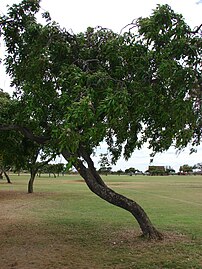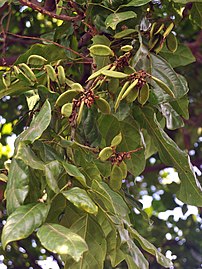Pongamia
| Pongamia | |
|---|---|

| |
| Flowers | |
| Scientific classification | |
| Kingdom: | Plantae |
| Clade: | Tracheophytes |
| Clade: | Angiosperms |
| Clade: | Eudicots |
| Clade: | Rosids |
| Order: | Fabales |
| Family: | Fabaceae |
| Subfamily: | Faboideae |
| Tribe: | Millettieae |
| Genus: | Pongamia Adans. (1763), nom. cons. |
| Species: | P. pinnata
|
| Binomial name | |
| Pongamia pinnata | |
| Varieties[1] | |
| |
| Synonyms[1] | |
|
List
| |
Pongamia pinnata is a species of tree in the pea family, Fabaceae, native to eastern and tropical Asia, Australia, and the Pacific islands.[1][2][3][4] It is the sole species in genus Pongamia.[5] It is often known by the synonym Millettia pinnata. Its common names include Indian beech, Karanja, and Pongame oiltree.[3][4]
Description
[edit]Pongamia pinnata is a legume tree that grows to about 15–25 m (50–80 ft) in height with a large canopy that spreads equally wide and creates dense shade. It may be deciduous for short periods. It has a straight or crooked trunk, 50–80 cm (20–30 in) in diameter, with grey-brown bark, which is smooth or vertically fissured. Its wood is white colored.[6] Branches are glabrous with pale stipulate scars. The imparipinnate leaves of the tree alternate and are short-stalked, rounded, or cuneate at the base, ovate or oblong along the length, obtuse-acuminate at the apex, and not toothed on the edges. They are a soft, shiny burgundy when young, and mature to a glossy, deep green as the season progresses, with prominent veins underneath.[7]
Flowering generally starts after 3–4 years with small clusters of white, purple, and pink flowers blossoming throughout the year.[8] The raceme-like inflorescences bear two to four flowers that are strongly fragrant and grow to be 15–18 mm (0.59–0.71 in) long. The calyx of the flowers is bell-shaped and truncated, while the corolla is a rounded ovate shape with basal auricles and often with a central blotch of green color.[4][9]
Croppings of indehiscent pods can occur by 4–6 years. The brown seed pods appear immediately after flowering, and mature in 10 to 11 months. The pods are thick-walled, smooth, somewhat flattened, and elliptical, but slightly curved with a short, curved point. The pods contain within them one or two bean-like brownish-red seeds, but because they do not split open naturally, the pods need to decompose before the seeds can germinate. The seeds are about 1.5–2.5 cm (0.59–0.98 in) long with a brittle, oily coat, and are unpalatable in natural form to herbivores.[7][9][6]
Pongamia pinnata is an outbreeding diploid legume tree, with a diploid chromosome number of 22.[9] Root nodules are of the determinate type (as those on soybean and common bean) formed by the causative bacterium Bradyrhizobium.
-
In Oahu, Hawaii
-
Inflorescence
-
Pollen grains
-
Fruits
-
Leaves with galls
-
Pods, Rempek beach, Gangga, North Lombok
Range and habitat
[edit]The species is naturally distributed in tropical and temperate Asia, from India to Japan to Thailand to Malesia to north and northeastern Australia to some Pacific islands;[2][4] It has been propagated and distributed farther around the world in humid and subtropical environments from sea level to 1,360 m (Chingola, Zambia), although in the Himalayan foothills, it is not found above 600 m.[10] Withstanding temperatures slightly below 0 °C (32 °F) and up to about 50 °C (122 °F) and annual rainfall of 500–2,500 mm (20–98 in), the tree grows wild on sandy and rocky soils, including oolitic limestone, and will grow in most soil types, even with its roots in salt water.[11]
The tree is well suited to intense heat and sunlight, and its dense network of lateral roots and its thick, long taproot make it drought tolerant. The dense shade it provides slows the evaporation of surface water and its root nodules promote nitrogen fixation, a symbiotic process by which gaseous nitrogen (N2) from the air is converted into ammonium (NH4+, a form of nitrogen available to the plant). M. pinnata is also a freshwater flooded forest species, as it can survive total submergence in water for few months continuously. M. pinnata trees are common in Tonlesap lake swamp forests in Cambodia.[citation needed]
P. pinnata is now broadly distributed across India, Asia, Africa, northern Australia, and the Pacific and Caribbean Islands and it has been cultivated and transported since the nineteenth century or earlier. As a result, some literature declares M. pinnata naturalized in Africa and certain parts of the United States, while its status as naturalized or native is uncertain in other regions.[12]
Taxonomy
[edit]The species was first described as Cytisus pinnatus by Carl Linnaeus in 1753. In 1898, Jean Baptiste Louis Pierre reclassified it as Pongamia pinnata.[1] In 1984, Robert Geesink concluded that species of Pongamia and Millettia were easily confused, and consolidated the Pongamia species into Millettia. Subsequent studies revealed that Millettia pinnata was paraphyletic within Millettia, and the species was reclassified as Pongamia pinnata, the sole species in the revived genus Pongamia.[13]
Uses
[edit]Pongamia pinnata is well-adapted to arid zones, and has many traditional uses. It is often used for landscaping as a windbreak or for shade due to the large canopy and showy, fragrant flowers. The flowers are used by gardeners as compost for plants. The bark may be used to make twine or rope, and it also yields a black gum that has historically been used to treat wounds caused by poisonous fish. The wood is said to be beautifully grained, but splits easily when sawn, thus relegating it to firewood, posts, and tool handles.[10] The tree's deep taproot and drought tolerance makes this tree ideal for controlling soil erosion and binding sand dunes.[10]
Pongamia pinnata seeds generally contain oil (27-39%), protein (17-37%), starch (6-7%), crude fiber (5-7%), moisture (15-20%), and ash content (2-3%). Nearly half of the oil content of P. pinnata seeds is oleic acid.[14] Oil made from the seeds, known as pongamia oil, has been used as lamp oil, in soapmaking, and as a lubricant. The oil has a high content of triglycerides. Its disagreeable taste and odor are due to bitter flavonoid constituents, including karanjin, pongamol, tannin, and karanjachromene.[11] These compounds induce nausea and vomiting if ingested in its natural form. The fruits, sprouts and seeds are used in traditional medicine.[11]
It can be grown in rainwater harvesting ponds up to 6 m (20 ft) in water depth without losing its greenery and remaining useful for biodiesel production.[15][16] Studies have shown seedlings with tolerance to salinity levels between 12 and 19 dS/m,[17] with an ability to tolerate salinity stresses of 32.5 dS/m.[18]

The seed oil has been found to be useful in diesel generators, and along with Jatropha and castor, it is being explored in hundreds of projects throughout India and the third world as feedstock for biodiesel.[19] P. pinnata as a biofuel is commercially valuable to the rural populations of places such as India and Bangladesh, where the plant grows abundantly, because it can support the socioeconomic development of these areas.[20][21]
Several unelectrified villages have used pongamia oil, simple processing techniques, and diesel generators to create their own grid systems to run water pumps and electric lighting.[22]
Research indicates potential use of P. pinnata as a food source for cattle, sheep, and poultry, as its byproduct contains up to 30% protein.[23][24] As adaptive uses are increasing, the tree is being planted in former citrus growing regions that have declined in Florida and California because of disease and climate change conditions.[25]
References
[edit]- ^ a b c d Pongamia pinnata (L.) Pierre. Plants of the World Online. Retrieved 16 September 2023.
- ^ a b "Pongamia". Germplasm Resources Information Network. Agricultural Research Service, United States Department of Agriculture. Retrieved 2010-05-02.
- ^ a b "Plants profile for Millettia pinnata (pongame oiltree)". PLANTS Profile. United States Department of Agriculture. Retrieved 2012-03-30.
- ^ a b c d F.A. Zich; B.Hyland; T. Whiffen; R.A. Kerrigan. "Pongamia pinnata var. pinnata". Australian Tropical Rainforest Plants (RFK8). Centre for Plant Biodiversity Research, Australian Government. Retrieved 26 May 2021.
- ^ Pongamia Adans. Plants of the World Online. Retrieved 16 September 2023.
- ^ a b Argent, G., A. Saridan, EJF. Campbell, & P. Wilkie. "Leguminosae". Manual of The Larger and More Important Non-Dipterocarp Trees of Central Kalimantan, Indonesia. :366. Samarinda: Forest Research Institute.
- ^ a b Orwa C.; Mutua A.; Kindt R.; Jamnadass R.; Simons A. (2009). "Pongamia pinnata; Fabaceae - Papilionoideae; (L.) Pierre; pongam, karanj, karanga, kanji" (PDF). Agroforestry Database version 4.0. Retrieved 2013-11-27.
- ^ Giesen, W., S. Wulffraat, M. Zierenand & L. Scholten (2007). Mangrove Guidebook for Southeast Asia[permanent dead link]: 198-9. Bangkok :FAO and Wetlands International. ISBN 974-7946-85-8
- ^ a b c "Weed Risk Assessment : Pongamia" (PDF). Daff.qld.gov.au. Retrieved 2013-11-21.
- ^ a b c Pongamia pinnata - a nitrogen fixing tree for oilseed Archived 2016-01-17 at the Wayback Machine
- ^ a b c "Factsheet from New crops at Purdue University". Hort.purdue.edu. 1998-01-08. Retrieved 2013-09-28.
- ^ "Pongamia Risk Assessment" (PDF). Retrieved 22 July 2021.
- ^ Wendy E. Cooper, Darren M. Crayn, Frank A. Zich, Rebecca E. Miller, Melissa Harrison, Lars Nauheimer "A review of Austrocallerya and Pongamia (Leguminosae subfamily Papilionoideae) in Australia, and the description of a new monotypic genus, Ibatiria," Australian Systematic Botany, 32(4), 363-384, (29 August 2019) https://doi.org/10.1071/SB18039
- ^ "Pongamia Factsheet" (PDF). Archived from the original (PDF) on 2013-05-01. Retrieved 2013-09-28.
- ^ "Rain water harvesting by fresh water flooded forests". Scribd.com. Retrieved 2013-09-28.
- ^ Degani, Erika; Prasad, M. V. R.; Paradkar, Anant; et al. (2022-12-15). "A critical review of Pongamia pinnata multiple applications: From land remediation and carbon sequestration to socioeconomic benefits". Journal of Environmental Management. 324: 116297. Bibcode:2022JEnvM.32416297D. doi:10.1016/j.jenvman.2022.116297. ISSN 0301-4797. PMID 36174475. S2CID 252558634.
- ^ Tomar, O. S.; Gupta, R. K. (1985-10-01). "Performance of some forest tree species in saline soils under shallow and saline water-table conditions". Plant and Soil. 87 (3): 329–335. Bibcode:1985PlSoi..87..329T. doi:10.1007/BF02181900. ISSN 1573-5036. S2CID 12335333.
- ^ Singh, K (1990). "Effect of soil salinity and sodicity on seedling growth and mineral composition of Pongamia pinnata and Araucaria cunninghamii". Tropical Ecology. 31 (2): 124–130 – via CAB Direct.
- ^ Karmee, SK; Chadha, A (2005). "Preparation of biodiesel from crude oil of Pongamia pinnata". Bioresource Technology. 96 (13): 1425–9. Bibcode:2005BiTec..96.1425K. doi:10.1016/j.biortech.2004.12.011. PMID 15939268.
- ^ Halder, P. K.; Paul, N.; Beg, M. R. A. (18 December 2014). "Prospect of Pongamia pinnata (Karanja) in Bangladesh: A Sustainable Source of Liquid Fuel". Journal of Renewable Energy. 2014: 1–12. doi:10.1155/2014/647324.
- ^ Kesari, Vigya; Rangan, Latha (September 2010). "Development of Pongamia pinnata as an alternative biofuel crop — current status and scope of plantations in India". Journal of Crop Science and Biotechnology. 13 (3): 127–137. doi:10.1007/s12892-010-0064-1. S2CID 2790680. Retrieved 23 July 2021.
- ^ "On Biodiesel". Tve.org. Archived from the original on April 26, 2012. Retrieved 2013-09-28.
- ^ Scott, Paul T.; Pregelj, Lisette; Chen, Ning; Hadler, Johanna S.; Djordjevic, Michael A.; Gresshoff, Peter M. (2008). "Pongamia pinnata: An Untapped Resource for the Biofuels Industry of the Future". BioEnergy Research. 1 (1): 2. Bibcode:2008BioER...1....2S. doi:10.1007/s12155-008-9003-0. S2CID 37994181.
- ^ Heuzé V., Tran G., Delagarde R., Hassoun P., Bastianelli D., Lebas F., 2017. Karanja (Millettia pinnata). Feedipedia, a programme by INRA, CIRAD, AFZ and FAO. https://www.feedipedia.org/node/636
- ^ Frisaro, Freida, Pongamia trees grow where citrus once flourished, offering renewable energy and plant-based protein, Associated Press, July 6, 2024
- Millettieae
- Flora of the Indian subcontinent
- Flora of Southeast Asia
- Flora of Japan
- Flora of Taiwan
- Flora of Malesia
- Flora of Papuasia
- Flora of Melanesia
- Flora of the Northern Territory
- Flora of Queensland
- Fabales of Asia
- Fabales of Australia
- Biofuel in India
- Biodiesel feedstock sources
- Sustainable agriculture
- Plants described in 1753
- Taxa named by Carl Linnaeus
- Taxa named by Jean Baptiste Louis Pierre






